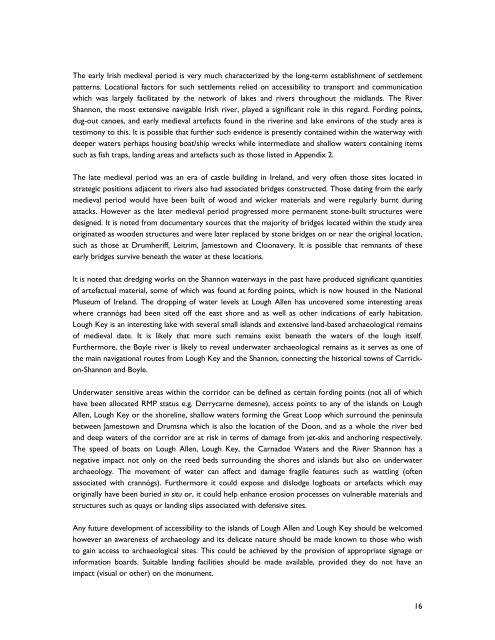archaeological & built heritage assessment - The Heritage Council
archaeological & built heritage assessment - The Heritage Council
archaeological & built heritage assessment - The Heritage Council
You also want an ePaper? Increase the reach of your titles
YUMPU automatically turns print PDFs into web optimized ePapers that Google loves.
<strong>The</strong> early Irish medieval period is very much characterized by the long-term establishment of settlement<br />
patterns. Locational factors for such settlements relied on accessibility to transport and communication<br />
which was largely facilitated by the network of lakes and rivers throughout the midlands. <strong>The</strong> River<br />
Shannon, the most extensive navigable Irish river, played a significant role in this regard. Fording points,<br />
dug-out canoes, and early medieval artefacts found in the riverine and lake environs of the study area is<br />
testimony to this. It is possible that further such evidence is presently contained within the waterway with<br />
deeper waters perhaps housing boat/ship wrecks while intermediate and shallow waters containing items<br />
such as fish traps, landing areas and artefacts such as those listed in Appendix 2.<br />
<strong>The</strong> late medieval period was an era of castle building in Ireland, and very often those sites located in<br />
strategic positions adjacent to rivers also had associated bridges constructed. Those dating from the early<br />
medieval period would have been <strong>built</strong> of wood and wicker materials and were regularly burnt during<br />
attacks. However as the later medieval period progressed more permanent stone-<strong>built</strong> structures were<br />
designed. It is noted from documentary sources that the majority of bridges located within the study area<br />
originated as wooden structures and were later replaced by stone bridges on or near the original location,<br />
such as those at Drumheriff, Leitrim, Jamestown and Cloonavery. It is possible that remnants of these<br />
early bridges survive beneath the water at these locations.<br />
It is noted that dredging works on the Shannon waterways in the past have produced significant quantities<br />
of artefactual material, some of which was found at fording points, which is now housed in the National<br />
Museum of Ireland. <strong>The</strong> dropping of water levels at Lough Allen has uncovered some interesting areas<br />
where crannógs had been sited off the east shore and as well as other indications of early habitation.<br />
Lough Key is an interesting lake with several small islands and extensive land-based <strong>archaeological</strong> remains<br />
of medieval date. It is likely that more such remains exist beneath the waters of the lough itself.<br />
Furthermore, the Boyle river is likely to reveal underwater <strong>archaeological</strong> remains as it serves as one of<br />
the main navigational routes from Lough Key and the Shannon, connecting the historical towns of Carrickon-Shannon<br />
and Boyle.<br />
Underwater sensitive areas within the corridor can be defined as certain fording points (not all of which<br />
have been allocated RMP status e.g. Derrycarne demesne), access points to any of the islands on Lough<br />
Allen, Lough Key or the shoreline, shallow waters forming the Great Loop which surround the peninsula<br />
between Jamestown and Drumsna which is also the location of the Doon, and as a whole the river bed<br />
and deep waters of the corridor are at risk in terms of damage from jet-skis and anchoring respectively.<br />
<strong>The</strong> speed of boats on Lough Allen, Lough Key, the Carnadoe Waters and the River Shannon has a<br />
negative impact not only on the reed beds surrounding the shores and islands but also on underwater<br />
archaeology. <strong>The</strong> movement of water can affect and damage fragile features such as wattling (often<br />
associated with crannógs). Furthermore it could expose and dislodge logboats or artefacts which may<br />
originally have been buried in situ or, it could help enhance erosion processes on vulnerable materials and<br />
structures such as quays or landing slips associated with defensive sites.<br />
Any future development of accessibility to the islands of Lough Allen and Lough Key should be welcomed<br />
however an awareness of archaeology and its delicate nature should be made known to those who wish<br />
to gain access to <strong>archaeological</strong> sites. This could be achieved by the provision of appropriate signage or<br />
information boards. Suitable landing facilities should be made available, provided they do not have an<br />
impact (visual or other) on the monument.<br />
16
















